毛利哥:CSIS --中国在全球创新方面处于领先地位吗?
以下内容翻译自csis.org [战略与国际研究中心]
原始连接:https://chinapower.csis.org/china-innovation-global-leader/
创新是创造新知识和新思想的过程。创新领域的全球领导者创造了塑造现代世界的科学发现和技术进步,使其对国家力量至关重要。一个经济体的创新能力取决于多种因素,包括它对研究和发展的承诺、劳动力的质量和政府机构的有效性。随着中国经济的升级,其创新优势和弱点将塑造其长期的经济竞争力和全球领导的前景。
Innovation is the process by which new knowledge and ideas are created. Global leaders in innovation produce the scientific discoveries and technological advances that shape the modern world, making it critical to national power. An economy’s capacity to innovate is dependent on a variety of factors, including its commitment to research and development, the quality of its workforce, and the effectiveness of government institutions. As China works to upgrade its economy, its innovative strengths and weaknesses will shape its long-term economic competitiveness and prospects for global leadership.
全球创新指数(GII)Global Innovation Index
全球创新指数(GII)是按其创新能力和产出对120多个经济体进行的年度排名。GII根据每个经济体在七个不同创新支柱中的表现对其进行评分和排名。使用下面的互动工具比较不同经济体在全球信息基础设施中的表现。单击“播放”按钮以动画形式显示随时间的更改。
The Global Innovation Index (GII) is an annual ranking of more than 120 economies by their innovation capabilities and output. The GII scores and ranks each economy based on its performance within seven different pillars of innovation. Use the below interactive to compare how different economies perform in the GII. Click the play button to animate change over time.

以下红点所代表的国家
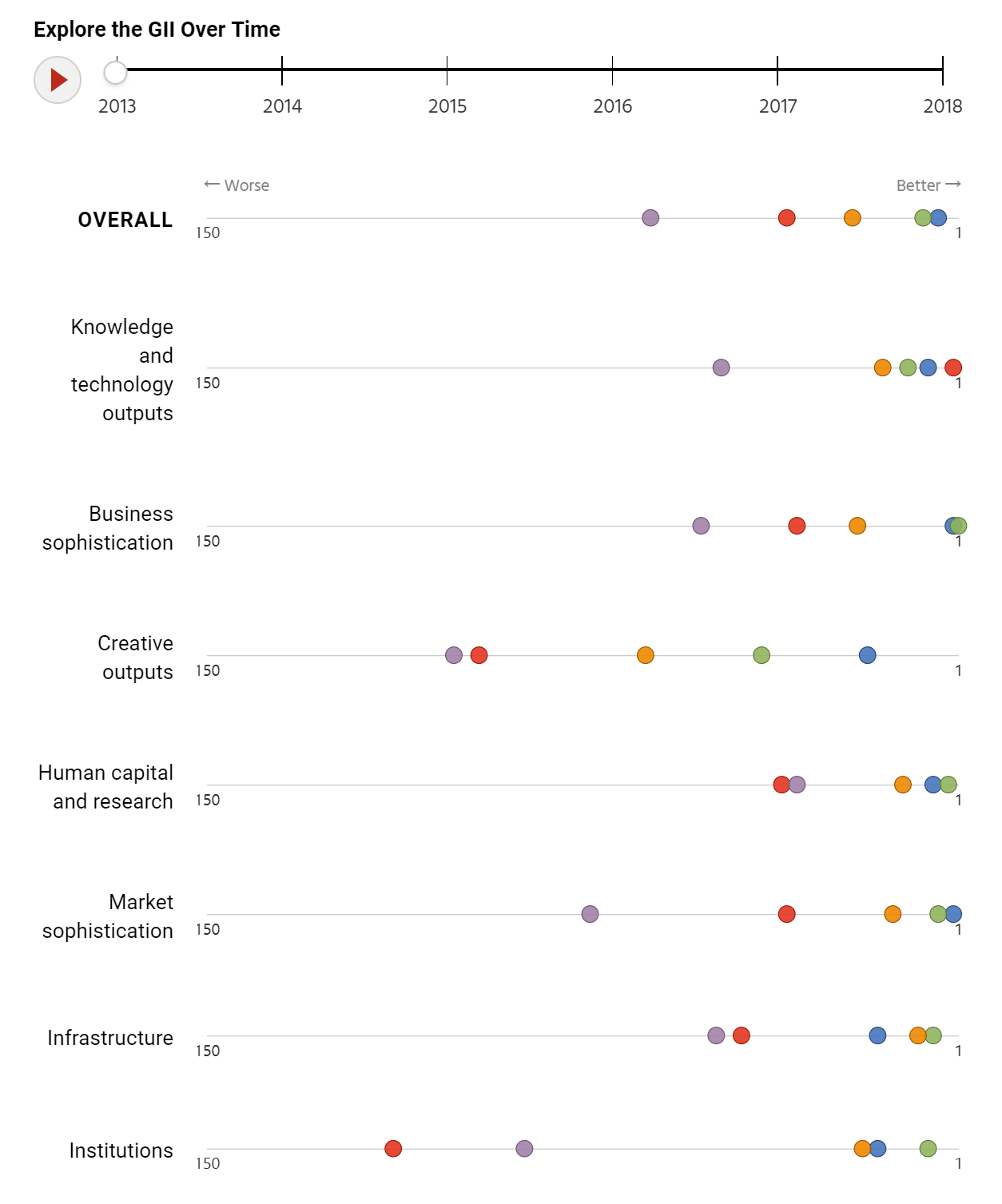
2013年中国和世界其他先进国家的全球创新指数(GII)对比
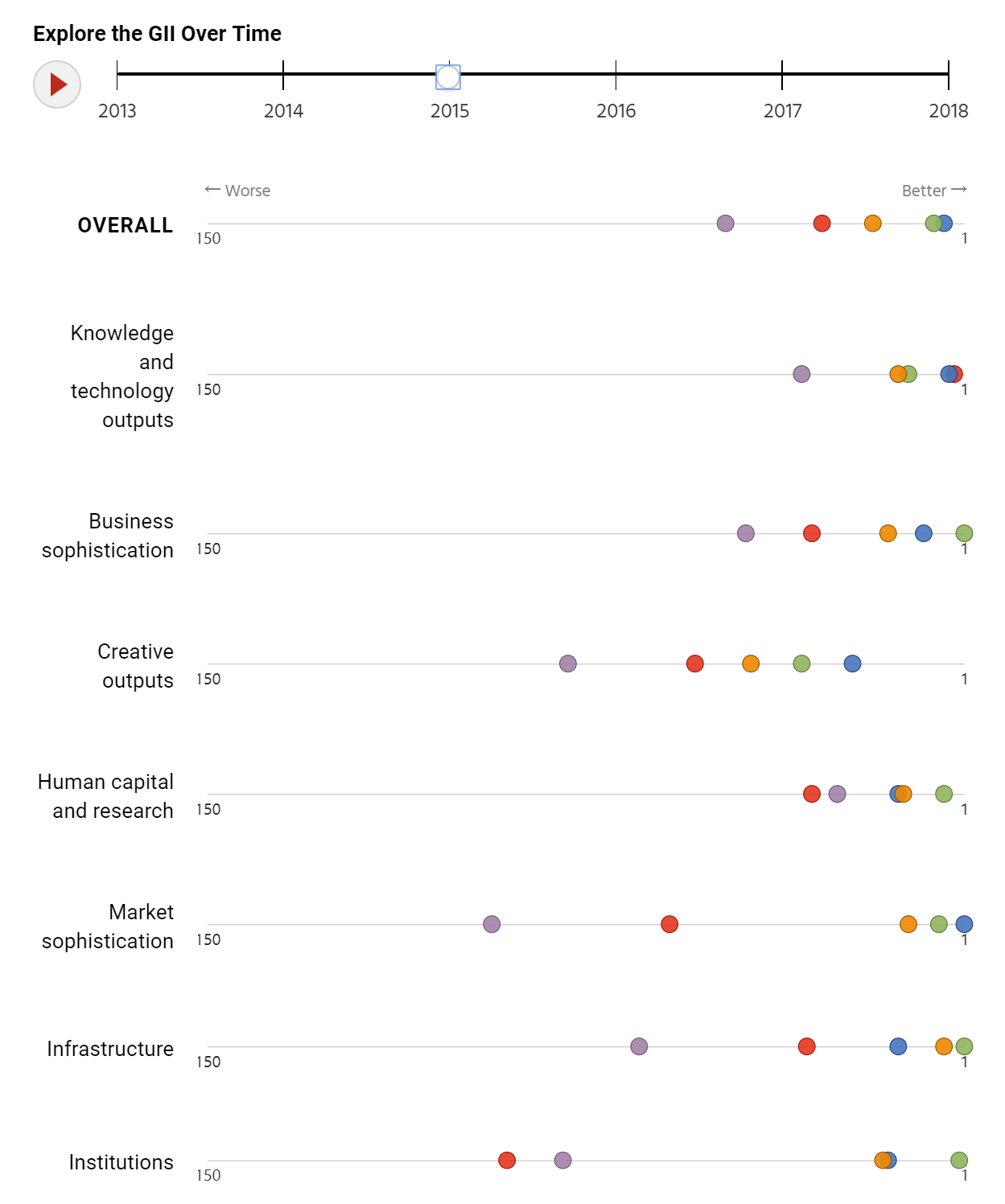
2015年中国和世界其他先进国家的全球创新指数(GII)对比

2018年中国和世界其他先进国家的全球创新指数(GII)对比
毛利哥注:从过往5年的变化中,我们可以看到中国的GII指数变化之快,从2013年我们GII指数排名在第35名,到2018年我们排名第17名,变化速度是全球最快的。
2018年前20强GII指数分别是
1 - 瑞士
2 - 荷兰
3 - 瑞典
4 - 英国
5 - 新加坡
6 - 美国
7 - 芬兰
8 - 丹麦
9 - 德国
10 - 爱尔兰
11 - 以色列
12 - 韩国
13 - 日本
14 - 中国香港
15 - 卢森堡
16 - 法国
17 - 中国
18 - 加拿大
19 - 挪威
20 - 澳大利亚
中国的创新优势
China’s Strengths in Innovation
几十年的快速经济增长使中国能够投资于推动创新的关键领域,如研究和发展以及新知识产权的创造。这些投资提高了中国的全球投资指数排名,使其能够与美国和瑞典等发达经济体竞争。
Decades of rapid economic growth have enabled China to invest in key areas that drive innovation, such as research and development and the creation of new intellectual property. These investments have improved China’s GII ranking and enabled it to compete with advanced economies, such as the United States and Sweden.
研发是创新的支柱。它支持新产品和服务的开发,这可以促进增长和生产力。近几十年来,中国越来越重视研发,支出占国内生产总值的比重从1991年的0.72%上升到2017年的2.13%。尽管这低于经合组织2.37%的平均水平,但中国庞大的经济规模意味着其研发支出目前仅次于美国,为4427亿美元。
Research and development (R&D) is the backbone of innovation. It supports the development of new products and services, which can boost growth and productivity. In recent decades, China has increasingly prioritized R&D, with spending as a percent of GDP rising from 0.72 percent in 1991 to 2.13 percent in 2017. Although this is less than the OECD average of 2.37 percent, the immense size of China’s economy means that its R&D expenditure is now second only to the United States at $442.7 billion (in 2010 USD).
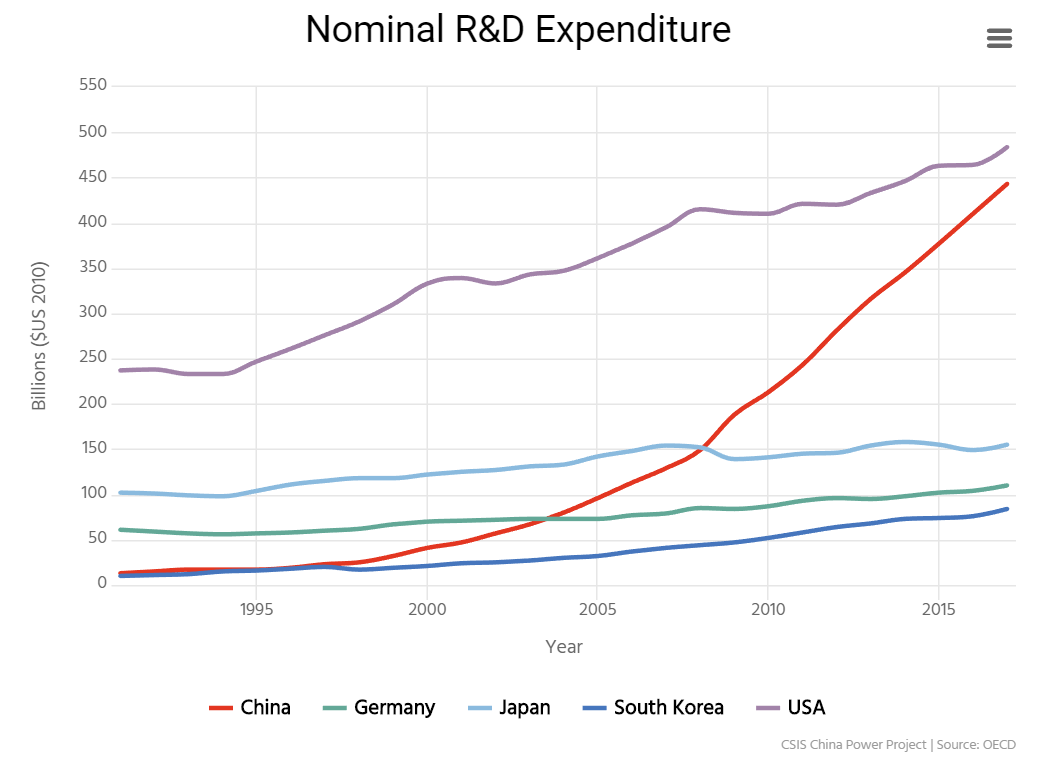
毛利哥注:我们可以看到中国字2000年开始科研费用的投入加速度领先全球!
研究与发展的进步促进了中国在全球信息基础设施领域的地位的提高,在全球商业成熟度排名第9位,仅次于美国,领先于爱尔兰。在发达经济体,企业通常为研究与发展举措提供大量资金。例如,经合组织国家的企业平均融资约占研发的60%。然而,在日本和韩国等国家,这一比例超过75%。这一趋势在中国得到了反映,2017年,中国企业为研发支出总额的76.5%(3388亿美元)提供了资金。
Advancements in R&D have contributed to China’s improved position in the GII, where it places 9th globally in Business Sophistication, just behind the US and ahead of Ireland.1 In developed economies, businesses typically finance a substantial portion of R&D initiatives. For instance, businesses in OECD countries on average finance around 60 percent of R&D. In countries like Japan and South Korea, however, this ratio is over 75 percent. This trend is mirrored in China, where businesses financed 76.5 percent ($338.8 billion) of the country’s gross expenditure on R&D in 2017.
国有企业(SOE)的重要性使评估企业在为中国研发提供资金方面的作用变得模糊不清。许多国企高管都在党和政府内任职,这意味着国企资助的研发活动往往与政府资助的研发活动一致。国有企业还享有从国有银行获得银行贷款的优惠条件,这降低了借贷成本,并为国有企业提供了比私营企业更强的财政支持。
Assessing the role of business in funding R&D in China is muddled by the importance of state-owned enterprises (SOEs). Many SOE executiveshave positions within the government and Chinese Communist Party, meaning R&D initiatives financed by SOEs often align with those funded by the government. SOEs also have preferential access to bank loans from state-owned banks, which reduces the cost of borrowing and provides SOEs with stronger financial backing compared to private companies.
中国的研发使用大多面向商业应用,这使得高等教育在中国的研发比例比其他地方要小。2008年至2017年,中国平均只有7.5%的研发是在大学和学院进行的。这远远低于荷兰(33.9%)、瑞典(26.2%)和英国(26.0%)等顶尖创新领袖,远低于经合组织的平均水平(17.9%)。
Much of China’s R&D usage is geared toward commercial applications, which has left higher education performing a smaller portion of R&D in China than elsewhere. Between 2008 and 2017, an average of just 7.5 percent of China’s R&D was performed at universities and academies. This is well below top innovation leaders like the Netherlands (33.9 percent), Sweden (26.2 percent), and the United Kingdom (26.0 percent), and considerably less than the OECD average (17.9 percent).
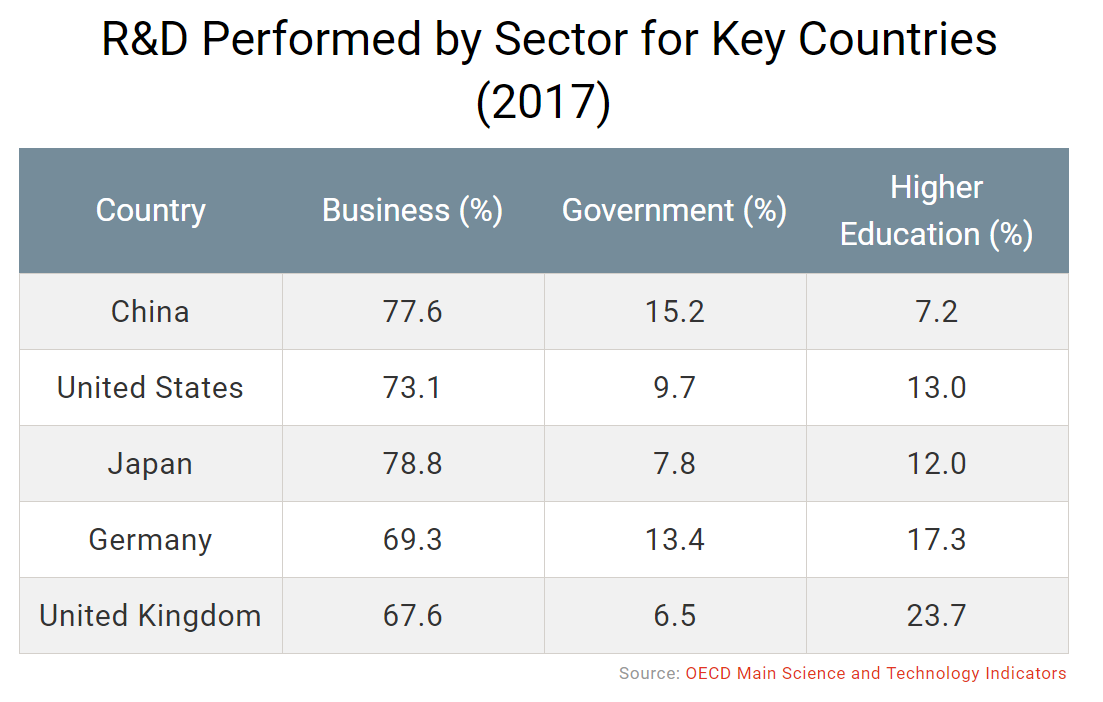
知识产权(IP)保护,如专利,对创新同样至关重要。它们为创新者提供法律保障,并作为衡量一个国家创新能力的一项有益措施。几十年来,中国一直依靠外国知识产权。2012年,世界银行企业调查发现,18%的中国企业报告使用外国企业的技术,这高于全球14.8%的平均水平,几乎是经合组织9.3%的平均水平的两倍。
Intellectual property (IP) protections, such as patents, are likewise critical for innovation. They provide legal safeguards for innovators and serve as a helpful measure of a country’s innovative capacity. For decades, China has leaned on foreign IP. In 2012, the World Bank Enterprise Surveys found that 18 percent of Chinese firms reported using technology from foreign businesses, which is higher than the global average of 14.8 percent, and nearly twice the OECD average of 9.3 percent.
中国政府已经采取了几项措施来完善中国的专利制度。2008年,中国政府启动了国家知识产权战略,并通过了对现行专利法的修订。国家专利发展战略于2010年公布。该计划提供了鼓励措施,以增加国内申请专利的数量,但它已导致专利被授予小的设计调整和增量变化,而不是完全新的发明。2019年1月对专利法提出了新的修正案。
Beijing has implemented several measures to improve China’s patent system. In 2008, the Chinese government launched a national IP strategy and passed revisions to its existing Patent Law. The National Patent Development Strategy was unveiled in 2010. The plan provides incentives to bolster the number of domestically filed patents, but it has resulted in patents being awarded for small design tweaks and incremental changes rather than entirely new inventions. New amendments to the Patent Law were proposed in January 2019.
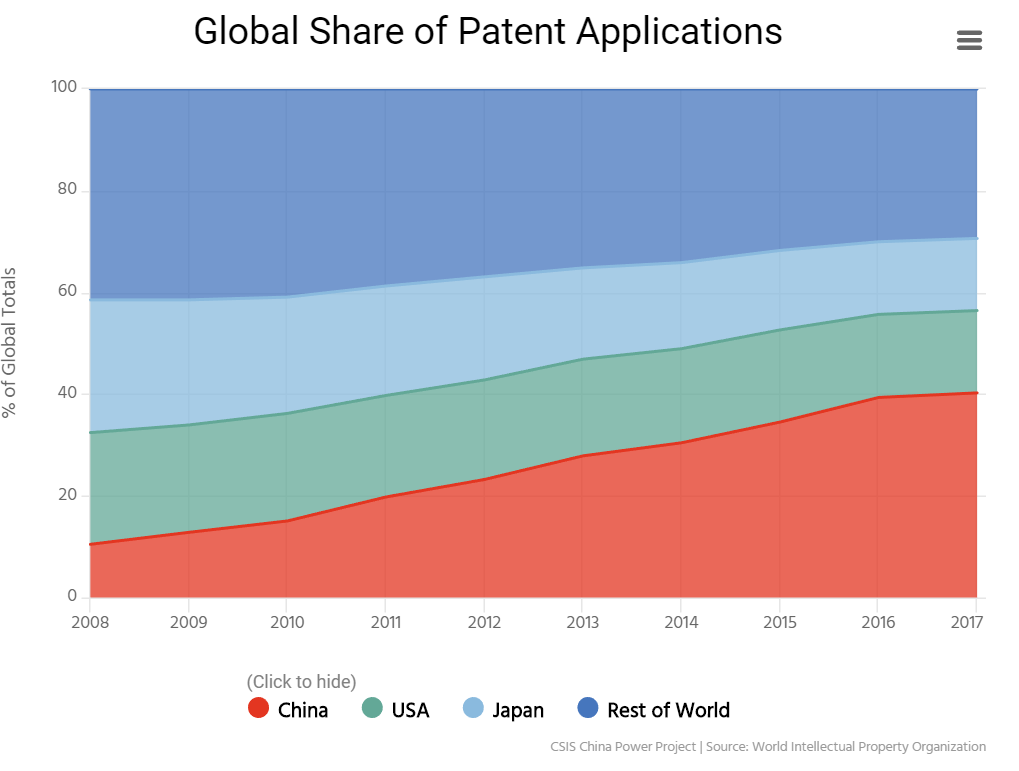
专利申请的全球份额(中国2017年占比40.2%)
政府的努力产生了影响。中国已迅速成为专利申请领域的世界领先者。根据世界知识产权组织(World Intelligent Property Organization)的数据,2007年中国申请了大约161000项专利,仅占全球专利申请总量的8.5%。十年后,中国申请了130多万件专利,占2017年全部专利申请的40%。这一高产出推动中国成为全球信息基础设施知识和技术输出支柱的前五名。
Government efforts have had an impact. China has rapidly become the world leader in patent applications. According to the World Intellectual Property Organization, China filed roughly 161,000 patent applications in 2007, accounting for just 8.5 percent of the global total. A decade later, China filed more than 1.3 million patent applications, accounting for 40 percent of all applications in 2017. This high output has propelled China to the top five in the Knowledge and Technology Outputs pillar of the GII.
尽管专利产量大幅增长,但中国专利仍然存在质量缺陷,导致对外国专利的持续依赖。2008年至2017年期间,中国向外国实体支付了1852亿美元购买知识产权,但中国知识产权仅从海外销售中产生了122亿美元。其中超过三分之一的收入来自2017年,当时年收入飙升至48亿美元。虽然中国的知识产权正变得越来越有价值,但仍有几家竞争对手表现出色。美国知识产权在2017年获得了惊人的1284亿美元;日本知识产权在同一年获得了417亿美元。
Despite significant growth in patent output, Chinese patents still suffer from qualitative weaknesses, leading to continued reliance on foreign patents. Between 2008 and 2017, China paid $185.2 billion to purchase IP rights from foreign entities, but Chinese IP only generated $12.2 billion from overseas sales. Over a third of these earnings came in 2017 alone, when annual revenue skyrocketed to $4.8 billion. While Chinese IP is becoming more valuable, it is still outperformed by several competitors. American IP raked in an incredible $128.4 billion in 2017; Japanese IP earned $41.7 billion in the same year.
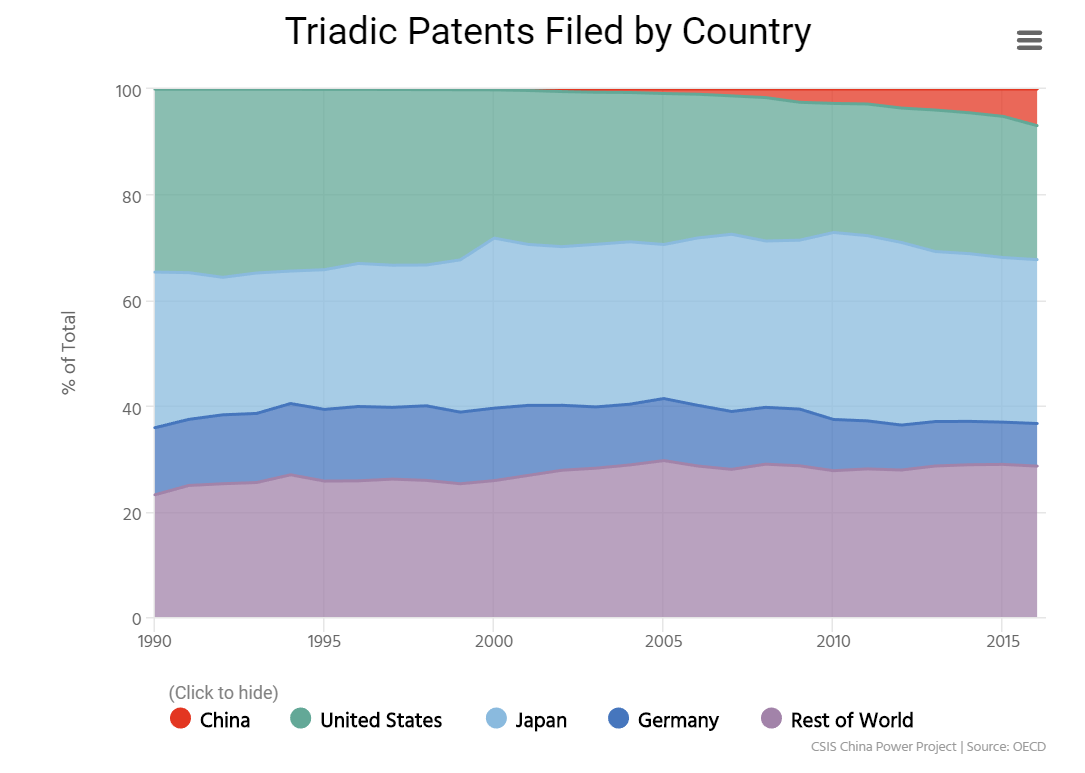
各国提交的三方专利
中国对三方专利总数的贡献相对较小,这一点也值得注意。这些专利——在日本、美国和欧盟共同申请——被认为是专利家族的黄金标准。三方专利很难获得,但通常比其他专利类型产生更多的收入。2016年,中国是三方专利的第四大贡献者,占6.9%,仅次于日本(31.0%)、美国(25.4%)和德国(8.1%)。
China’s relatively small contribution to the total number of triadic patents is also notable. These patents – filed jointly in Japan, the United States, and the European Union – are considered the gold standard among patent families. Triadic patents are difficult to obtain, but generally generate more revenue than other patent types. In 2016, China was the fourth largest contributor to triadic patents at 6.9 percent, behind Japan (31.0 percent), the United States (25.4 percent), and Germany (8.1 percent).
竞争但不引领创新
Competing but not Leading in Innovation
在创新的其他方面,中国正在进步,但仍落后于发达经济体。中小学教育的改善和初创企业的资金增加有助于促进中国的创新,但高等教育、商业环境和工作文化的问题依然存在。
In other aspects of innovation, China is progressing but still lags advanced economies. Improvements in primary and secondary education and increased funding for startups have helped promote Chinese innovation, but issues with tertiary education, business environment, and work culture persist.
在大量资金的支持下,政府的举措使中国的中小学入学率和识字率接近普遍水平。中国贫困地区的差距仍然存在,但值得注意的是,教育水平的提高提高了其创新能力。
Government initiatives, backed by significant funding, have enabled China to attain near-universal primary and secondary enrollment and literacy rates. Disparities continue to exist in China’s poorer regions, but noteworthy improvements in education have boosted its capacity to innovate.
在高等教育一级,尽管中国在2017年跌落的时间很短,但只有51%的高中学分进入高等教育机构。虽然这代表1997年从5.5 percent跳跃的一步,但它恰好在77个高收入国家的平均数下面,甚至在52个上中等收入国家的平均数下面。中国高等教育的质量也与其他国家一样,只有三所中国大学在2019年世界高等教育大学排名第100位。
At the tertiary level, however, China falls short.2 In 2017, only 51 percentof college-age Chinese were enrolled in institutions of higher education. Although this represents a steep jump from 5.5 percent in 1997, it is well below the 77 percent average of high-income countries, and even below the 52 percent average of upper-middle income countries. The quality of higher education in China also trails that of other countries, with only three Chinese universities listed in the top 100 of the 2019 Times Higher Education World University Rankings.
为了满足熟练工人的不断增长的需求,中国优先重视高等职业教育。教育部在2017年的高等职业学校花费近30万亿美元,比前一年增加了10.2倍。在二零零九年二月,北京未预见到两个新的国家教育计划的设计,以提高入学率,提高全国各地职业中心的素质。
To meet growing demand for skilled workers, China has prioritized tertiary vocational education. The Ministry of Education spent nearly $30 billion on tertiary vocational schools in 2017, a 10.2 percent increase from the previous year. In February 2019, Beijing unveiled two new national education plans designed to boost access to and the quality of vocation centers across the country
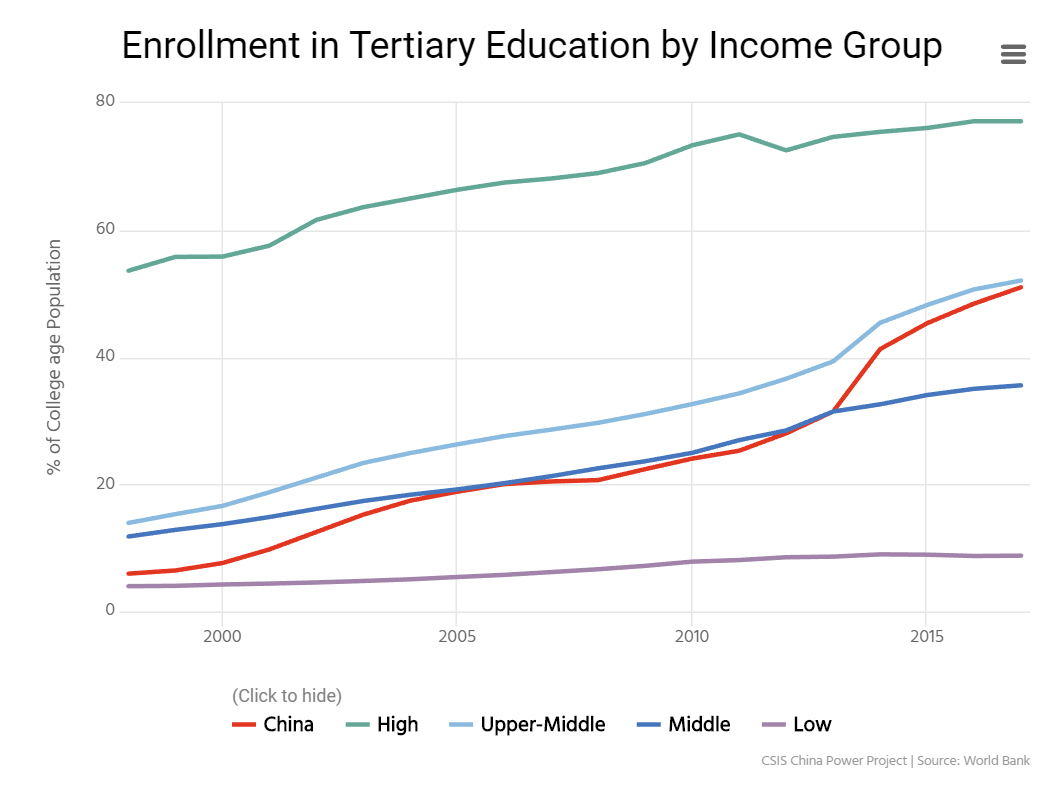
按收入组别分列的高等教育入学人数
中国的商业环境既有优缺点。城市中心区的初创企业比以往任何时候都吸引了更多的风险投资,但商业法规和工作场所文化的问题阻碍了创新。这些因素促成了中国在全球第25大金融机构市场成熟度支柱中表现平平,中国位于拉脱维亚之后,阿塞拜疆之前。
China’s business environment exhibits both strengths and weaknesses. Startups in urban hubs are attracting more venture capital than ever before, but problems with business regulations and workplace culture inhibit innovation. These factors have contributed to China’s lackluster performance in the GII’s Market Sophistication pillar, where China sits at 25th globally, just behind Latvia and ahead of Azerbaijan.
像北京、上海和杭州这样的城市中心已经开始挑战硅谷在培育初创企业方面的主导地位。这三个城市在2010-2012年和2015-2017年期间承担了全球风险投资增长30%以上的责任。它们还拥有中国75%的“独角兽”或价值至少10亿美元的初创企业。
Urban hubs like Beijing, Shanghai, and Hangzhou have begun to challenge Silicon Valley’s dominance in fostering startups. These three cities were responsible for more than 30 percent of global growth in venture capital investment during 2010-2012 and 2015-2017. They are also home to 75 percent of China’s “unicorns,” or startups with a value of at least $1 billion dollars.
然而,中国企业面临着相当大的障碍,使其难以运营和创新。尽管政府的措施有助于减少繁文缛节,这将创业的平均时间从2017年的22.9天减少到2018年的8.6天,但世界银行在190个经济体中排名第46位,以便于创业。影响因素包括法律障碍和信贷系统的问题。
Nevertheless, Chinese companies face considerable hurdles that make it difficult to operate and innovate. Although government measures have helped reduce red tape, which has decreased the average time to start a business from 22.9 days in 2017 to 8.6 days in 2018, the World Bank rated China 46th out of 190 economies in ease of doing business. Contributing factors include legal roadblocks and problems with the credit system.
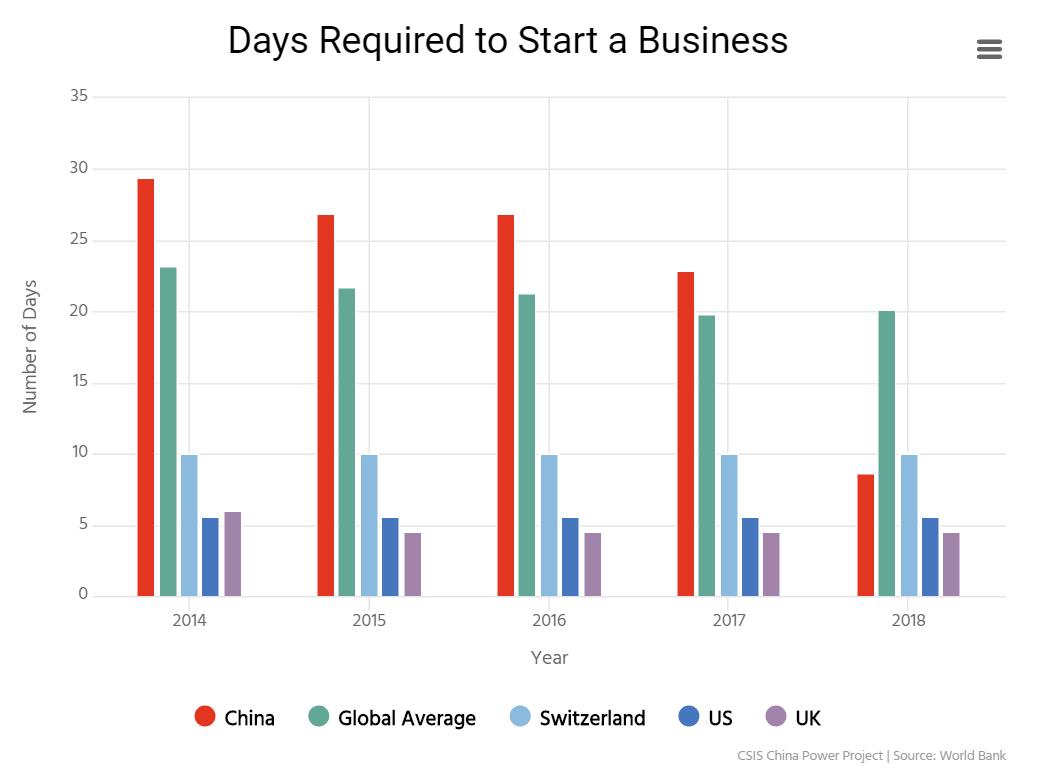
开业所需天数
工作场所文化给中国带来了更多的挑战。2018年全球竞争力指数(GCI)在140个经济体中,中国劳动力多样性排名第77位。作为创新和创业的软驱动力,工作场所的多样性可以促使企业创造性地解决问题并占领新市场。
Workplace culture presents additional challenges for China. The 2018 Global Competitiveness Index (GCI) ranked China 77th out of 140 economies in terms of workforce diversity. As a softer driver of innovation and entrepreneurship, workplace diversity can position firms to creatively solve problems and capture new markets.
中国的科技产业也因鼓励“996”文化而臭名昭著——每周6天从上午9点工作到晚上9点。一些著名的首席执行官,包括JD.com的刘强东(Richard Liu)和阿里巴巴(Alibaba)的马云(Jack Ma),都为这种做法辩护。有赞电子商务平台甚至要求员工遵守996。尽管中国和美国、日本等国都面临着过度工作的问题,但越来越多的证据表明,持续的过度工作不仅会适得其反,还会损害员工的健康。
The Chinese technology industry is also notorious for encouraging a “996” culture – working from 9 am to 9 pm 6 days per week. Some prominent CEOs, including Richard Liu of JD.com and Jack Ma of Alibaba, have gone so far as to defend the practice. E-commerce platform Youzan even demands employees abide by 996. While overworking is a problem that China shares with countries like the United States and Japan, there is growing evidence that sustained overworking is both counter-productive and detrimental to employee health.
毛利哥注:翻译就先到这里,其他有些内容不便发布,还请查看原文。总之,从数据分析角度来看,该文内容还是客观和中肯的,也非常坚定的可以看好中国的科技强国发展之路。




 扫一扫 下载APP
扫一扫 下载APP



